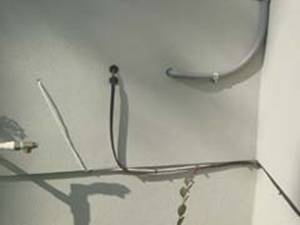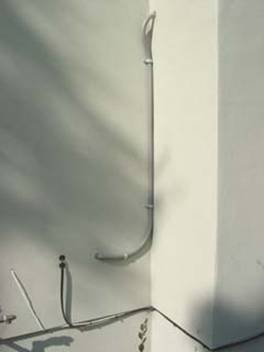A Practical HDMI Cable Solution & Installation
I recently moved into a new house located in the heart of the Historic District of Sanford, Florida. Yes, I did say new. Unfortunately, I wasn't the one who built the house nor did I have any influence on its construction. Everything in the house was perfect upon purchase with one very significant exception.
Every house I've ever purchased, built and lived in all had one thing in common. A room built for Home Theater. Regretfully I had to sacrifice that in this house and after a long debate with my wonderful wife, I had her agree to allow me to have a Home Theater System in our one and only living room. But there was a huge contingency attached to this contract. She did not want to see any wires. We'll, everyone knows the impossibility of this monumental task.
Arrangement of the Room
Setting up my ideal system in this room was a challenge, especially since it was not built for one. It certainly didn't help any having a fire place located right in the sweet spot for a TV Monitor and Center Channel Speaker. Knowing that there was no way my wife would allow me to block the fireplace with a rear projector TV, my only choice was to spend the extra money on a new Plasma HD and mount it above the fireplace. I know there's concern about doing that due to the heat coming from the fire place, but let me remind you that it's Florida . The most I ever burn is one of those magic logs for effect on the only two cold days we have a year.
So with that aside, I made my selection with a Pioneer 42" Plasma and purchased the optional mount for securing it to the wall. My primary concern was not knowing what to expect behind the fireplace chimney that may inhibit me from my only TV option. With the help of a friend in construction we learned that there were indeed studs located where we needed them, so without any further hesitation, the mounting proceeded.
Wiring the System
Remembering my "no wire" ultimatum, I faced the daunting task of having to wire the TV and the HD tuners behind and/or through the walls. This was to be my biggest challenge, considering that there were no coax cables or phone lines where the system rack was to be placed, and there certainly wasn't AC or an HDMI video line over the fireplace for the TV.
Again with the amazing help of my friend, we set forth to wire a two story house for three coax lines, one AC outlet, one phone line and to design a method of hiding the HDMI cable. Before going further I have to voice one of my biggest pet peeves. It simply amazes me that builders haven't yet figured out the one basic thing to do during ANY house construction.
Message to all builders: Put a phone line next to the cable line!
They sell panels that have one of each on them and they are easier to wire before hand than it is to have to add it after the walls are up and someone's moved in. As a new homeowner, I'll pay the extra 25 cents for this option.
After all the electric and phone lines were completed, I was faced with my next challenge. How do I run an HDMI cable from my system rack to the TV without seeing the wire?
HDMI Cable
I knew eventually that I'd have to figure out what to do about the HDMI cable. I also knew that I had to wait until I figured out the rest of the install before I could identify the length. Once I began crossing this bridge, I figured out that I needed an HDMI cable between 18 to 20' that could be run through the outside wall, across the house and up through the fireplace where the TV mounted. Wow, you say? Well it turns out that the only problem was purchasing the cable.
I decided to make a trip to the same Sound Advice where I purchase the Pioneer Plasma TV. When I inquired about an HDMI cable the sales person informed me that the longest length they carry was 2 meters. I then asked who the manufacturer was and how much it costs. This is where the story gets interesting. The cables that Sound Advice sells are from Audioquest. Yes, that would be the same Audioquest that favors using batteries for their "high end" speaker cables. I chuckled loudly and informed the person that I had heard of Audioquest through Audioholics. I was amazed to learn that all of the sales people, including the Sales Manager frequent Audioholics and use it as an informational tool. Knowing this, I faced the Sales Manager and asked him how they could sell Audioquest cables knowing about the Audioholics articles. He said sadly that it's Tweeter Company's decision, not his. But for grins, I continued with my inquiry on how much their 2 meter Audioquest costs. To my shock I was told that it was almost $200! I then asked what it would take to get 7 or 8 meter cable and he indicated that Sound Advice doesn't carry them and to get one that length would likely cost a small fortune.
Blue Jeans Cables to the Rescue
I quickly left the Sound Advice store and raced home in a haze thinking that my install would go no further taking this route. Dashing back to the Audioholics website, I researched an option for an affordable 18 to 20 foot HDMI cable that wouldn't break the bank. Low and behold, Blue Jeans Cable s pops up in a banner and off I went to their website. It took no more than two clicks and there before my eyes was a 7 meter HDMI cable for only $115! Now, I could buy a 2 meter cable for $200 from a battery distributor OR I could purchase a 7 meter cable from a legitimate cable vendor for $115. What was I missing here? One more click and the purchase was complete. All I had to do now was wait a couple of days for the Fed-Ex man to show up with the missing piece to my home theater puzzle.
Two days later the doorbell rang. When I opened the door it was everything I could do to not hug the Fed-Ex guy. I impatiently opened the package and completed the install I had started several days earlier.
How I Did It
The following set of pictures depicts the method to my madness in fulfilling my wife's wishes of a "no visible wire" Home Theater system.
The two black cables are the three coax cables I needed for TiVo and HDTV. I had to run those from the second story attic down the corner of the fireplace and through the outside wall. The lighter cable is the phone line required for updating the TV tuners. The large conduit contains the electric I ran for the TV and the HDMI cable.
New outlets and low voltage boxes were then added behind the audio rack. This allowed me to get access to all of the new cabling I had run. The same was added behind the television above the fireplace.
I completed the install and neatly wired the audio rack so that there was nothing easily visible from the front.
The Final Test
The excitement level grew as I prepared to fire up my Yamaha RX-V2600 for the first time with HDMI video. I was even more excited to know that I had finally reached the point of having one and only one cable running to my TV. I thought that HDMI would be the Valhalla of cables and the answer to Life, the Universe and Everything. Nothing could stop me now, right?
The Problem
Oh how wonderful it would be if that was actually true. I ran through all the video inputs using Yamaha's scaler and had no problems with the TiVo, the VCR and the DVD Player. Then I went for the gusto and switched over to my long awaited HDTV. That's when the fun began. When switching video inputs I noticed that the HDTV tuner was unable to lock onto a resolution. I nearly cried out loud. Before doing so, I called DirecTV to see if they could offer some assistance. After going through their advanced support center, we went through one simple test. The tech person asked me to connect the tuner directly from the HDMI cable to the TV therefore bypassing the Yamaha. And there it was; a picture. I was able to lock into any resolution I wanted with no problem. I then went back through the Yamaha and the same problem manifested again. DirecTV passed the buck at this time indicating that their tuner was doing its job. They were right... to a point.
With no where else to go I once again visited Audioholics to see if anyone else had this very same issue. It was then that I found an entire forum devoted to this same problem. It seemed as if almost everyone with an HDTV tuner (cable or satellite) has experienced the very same issue. The staff of Audioholics saw the forum grow with many speculations so they contacted Yamaha directly for information on what was going on. From this I learned that my brand new DirecTV H20 HDTV tuner was not compatible with my equally as new Yamaha RX-V2600. You see, this and many other HD tuners are not equipped to work with HDMI repeaters - which, in a simplified sense, is how the Yamaha behaves with respect to the satellite receiver.
The Solution
A simple firmware update from the satellite provided usually fixes the problem. The hard part is finding a competent tech on the other end of the line that is aware of this issue and has the solution for it. So there I was with my one cable fits all solution down the drain (at least for now). One alternative is to connect the HD Tuner to the Yamaha via Component Video and accept the fact that I couldn't have audio directly to my TV from the HD tuner. With that in mind, all my audio must pass through my Home Theater System, even when watching TV. Not that big a deal, just extra wife training.
Editor's Note on HDMI Switchers and the Cable/Satellite Dilemma
Another stop-gap option involves getting an external HDMI switcher, like the PureLink HDS-41R. With this, you can route the output of the Yamaha to one input and the output of the cable box or satellite receiver to another. So far, cable boxes we have tested can work with these external switchers, even though AV receivers seem to trip them up… Then, with some fancy macro programming on the remote control, you can still have a fairly smooth user experience. Getting the firmware fixes would be better, but let's face it - almost universally we experience a complete apathy towards this type of bleeding edge customer support from cable and satellite TV providers.
When I build up the nerve to call my satellite provider again, I will inquire on the firmware update. In the meantime, I will just enjoy listening to all of my favorite programs in surround sound (not a bad compromise) or consider purchasing an HDMI switcher.
Conclusion
The HDMI cable from Blue Jeans Cables became a significant and instrumental component of my system, especially when considering the length and the price. Using all video types through the Yamaha and feeding the Pioneer HDTV through the 7 meter HDMI cable proved to be a success. The video was crisp and without any noticeable loss of resolution.



